PCOS Case Study: Assessment, Role of Health Workers, and Education
VerifiedAdded on 2021/06/14
|11
|3079
|95
Case Study
AI Summary
This case study examines Sharon, a 26-year-old woman diagnosed with Polycystic Ovary Syndrome (PCOS), focusing on the diagnostic assessments, the role of sexual health team members, and the patient's educational needs. The assessment includes investigations into menstrual problems, family history, lifestyle factors, fertility, and insulin resistance. The role of sexual health workers, particularly nurses, in providing care, education, and pelvic examinations is emphasized. The educational needs for the patient encompass understanding the hormonal imbalances, potential risks of type 2 diabetes, and the importance of diet, exercise, and medication (Clomid) for managing the condition and achieving pregnancy. The case highlights the importance of a multidisciplinary approach in managing PCOS, including medical interventions, lifestyle modifications, and patient education to improve health outcomes and address fertility concerns.
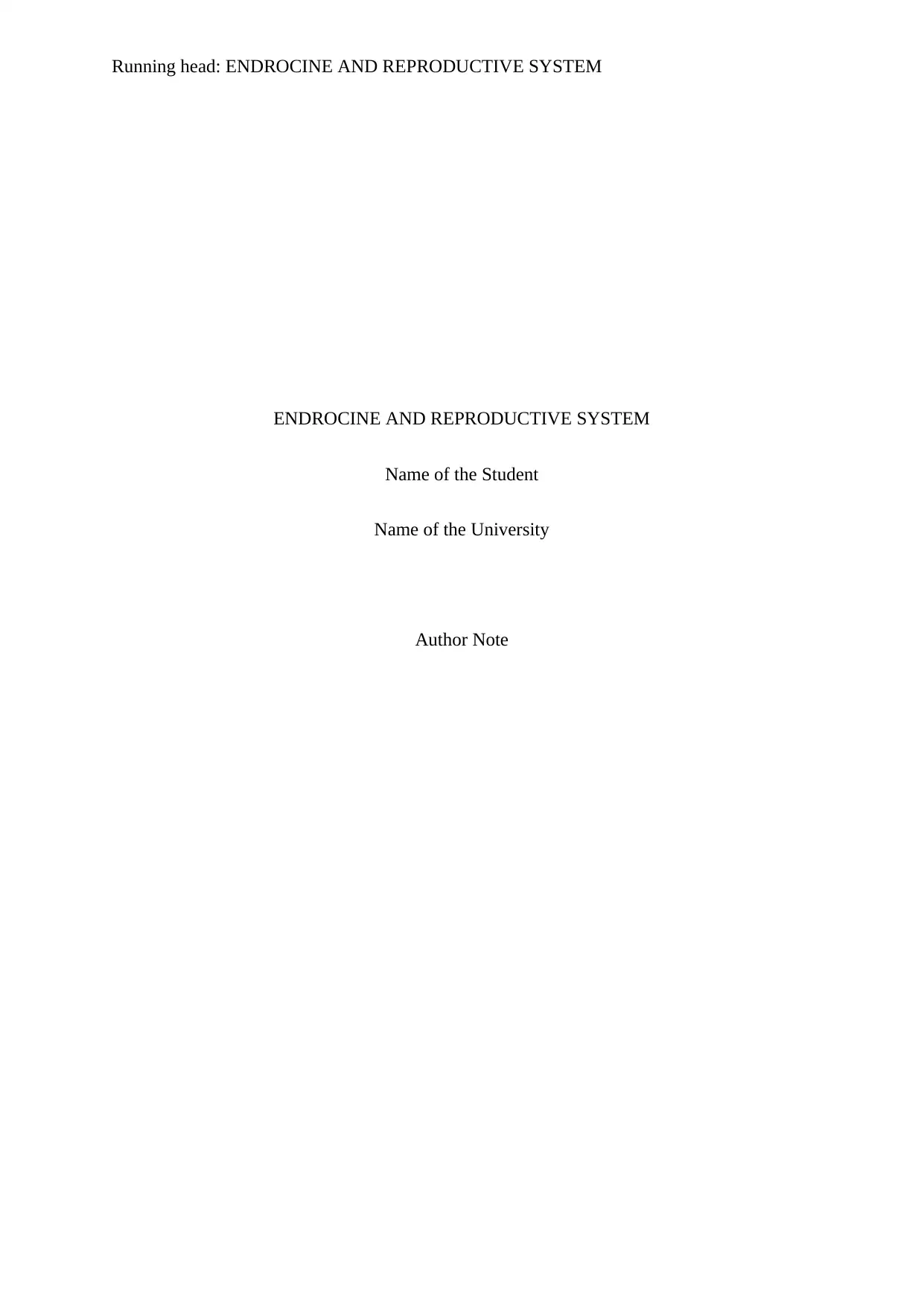
Running head: ENDROCINE AND REPRODUCTIVE SYSTEM
ENDROCINE AND REPRODUCTIVE SYSTEM
Name of the Student
Name of the University
Author Note
ENDROCINE AND REPRODUCTIVE SYSTEM
Name of the Student
Name of the University
Author Note
Paraphrase This Document
Need a fresh take? Get an instant paraphrase of this document with our AI Paraphraser
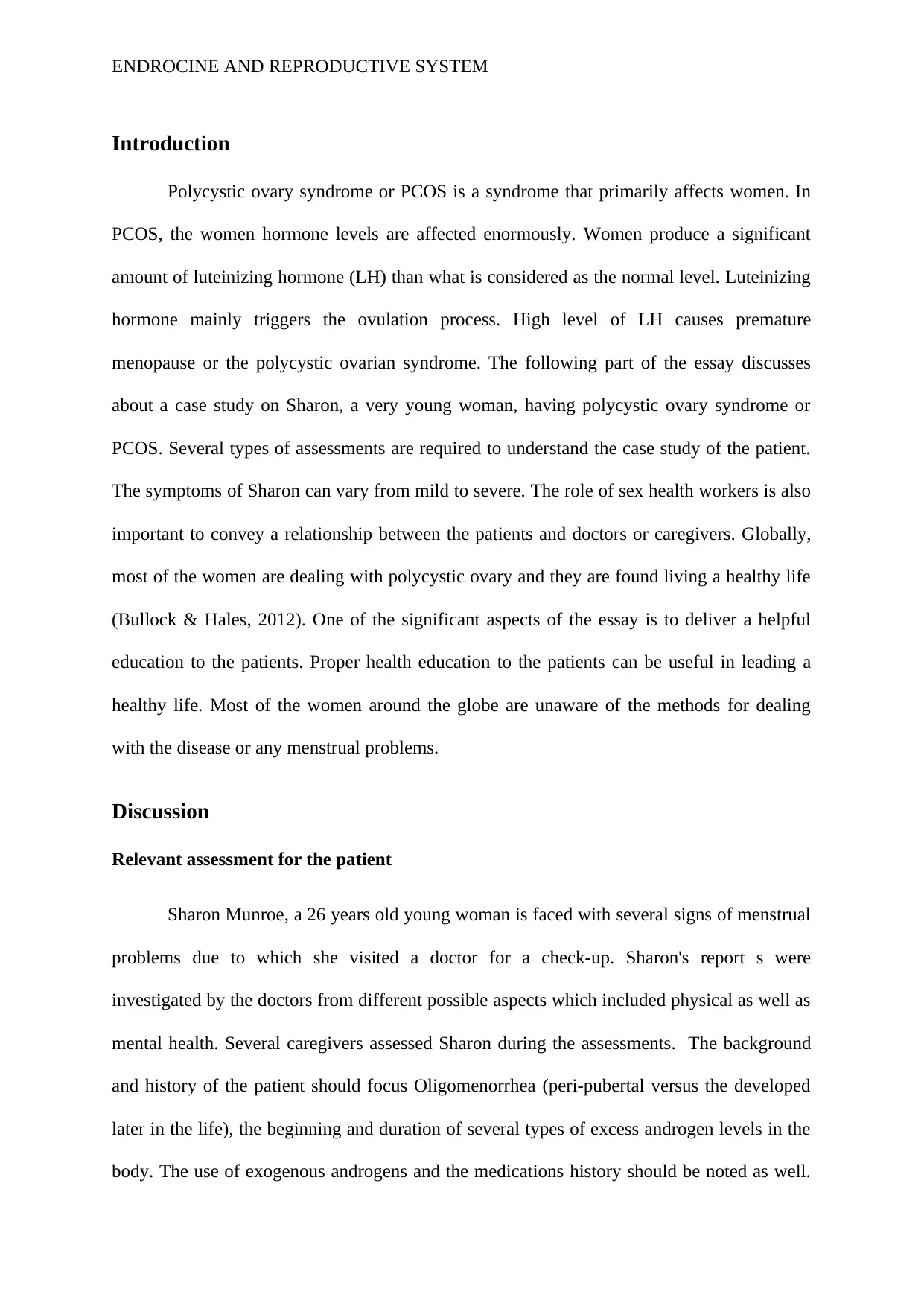
ENDROCINE AND REPRODUCTIVE SYSTEM
Introduction
Polycystic ovary syndrome or PCOS is a syndrome that primarily affects women. In
PCOS, the women hormone levels are affected enormously. Women produce a significant
amount of luteinizing hormone (LH) than what is considered as the normal level. Luteinizing
hormone mainly triggers the ovulation process. High level of LH causes premature
menopause or the polycystic ovarian syndrome. The following part of the essay discusses
about a case study on Sharon, a very young woman, having polycystic ovary syndrome or
PCOS. Several types of assessments are required to understand the case study of the patient.
The symptoms of Sharon can vary from mild to severe. The role of sex health workers is also
important to convey a relationship between the patients and doctors or caregivers. Globally,
most of the women are dealing with polycystic ovary and they are found living a healthy life
(Bullock & Hales, 2012). One of the significant aspects of the essay is to deliver a helpful
education to the patients. Proper health education to the patients can be useful in leading a
healthy life. Most of the women around the globe are unaware of the methods for dealing
with the disease or any menstrual problems.
Discussion
Relevant assessment for the patient
Sharon Munroe, a 26 years old young woman is faced with several signs of menstrual
problems due to which she visited a doctor for a check-up. Sharon's report s were
investigated by the doctors from different possible aspects which included physical as well as
mental health. Several caregivers assessed Sharon during the assessments. The background
and history of the patient should focus Oligomenorrhea (peri-pubertal versus the developed
later in the life), the beginning and duration of several types of excess androgen levels in the
body. The use of exogenous androgens and the medications history should be noted as well.
Introduction
Polycystic ovary syndrome or PCOS is a syndrome that primarily affects women. In
PCOS, the women hormone levels are affected enormously. Women produce a significant
amount of luteinizing hormone (LH) than what is considered as the normal level. Luteinizing
hormone mainly triggers the ovulation process. High level of LH causes premature
menopause or the polycystic ovarian syndrome. The following part of the essay discusses
about a case study on Sharon, a very young woman, having polycystic ovary syndrome or
PCOS. Several types of assessments are required to understand the case study of the patient.
The symptoms of Sharon can vary from mild to severe. The role of sex health workers is also
important to convey a relationship between the patients and doctors or caregivers. Globally,
most of the women are dealing with polycystic ovary and they are found living a healthy life
(Bullock & Hales, 2012). One of the significant aspects of the essay is to deliver a helpful
education to the patients. Proper health education to the patients can be useful in leading a
healthy life. Most of the women around the globe are unaware of the methods for dealing
with the disease or any menstrual problems.
Discussion
Relevant assessment for the patient
Sharon Munroe, a 26 years old young woman is faced with several signs of menstrual
problems due to which she visited a doctor for a check-up. Sharon's report s were
investigated by the doctors from different possible aspects which included physical as well as
mental health. Several caregivers assessed Sharon during the assessments. The background
and history of the patient should focus Oligomenorrhea (peri-pubertal versus the developed
later in the life), the beginning and duration of several types of excess androgen levels in the
body. The use of exogenous androgens and the medications history should be noted as well.
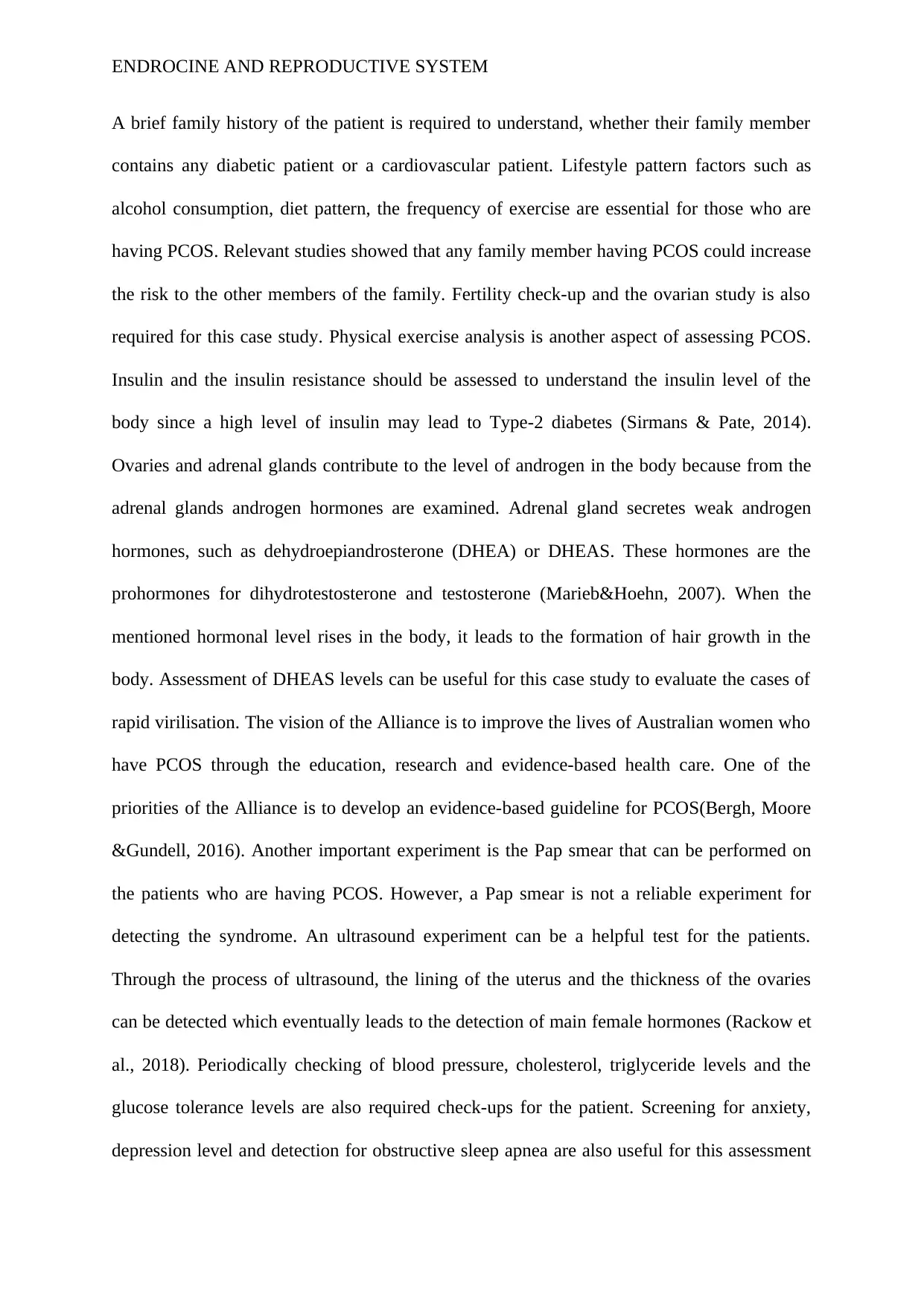
ENDROCINE AND REPRODUCTIVE SYSTEM
A brief family history of the patient is required to understand, whether their family member
contains any diabetic patient or a cardiovascular patient. Lifestyle pattern factors such as
alcohol consumption, diet pattern, the frequency of exercise are essential for those who are
having PCOS. Relevant studies showed that any family member having PCOS could increase
the risk to the other members of the family. Fertility check-up and the ovarian study is also
required for this case study. Physical exercise analysis is another aspect of assessing PCOS.
Insulin and the insulin resistance should be assessed to understand the insulin level of the
body since a high level of insulin may lead to Type-2 diabetes (Sirmans & Pate, 2014).
Ovaries and adrenal glands contribute to the level of androgen in the body because from the
adrenal glands androgen hormones are examined. Adrenal gland secretes weak androgen
hormones, such as dehydroepiandrosterone (DHEA) or DHEAS. These hormones are the
prohormones for dihydrotestosterone and testosterone (Marieb&Hoehn, 2007). When the
mentioned hormonal level rises in the body, it leads to the formation of hair growth in the
body. Assessment of DHEAS levels can be useful for this case study to evaluate the cases of
rapid virilisation. The vision of the Alliance is to improve the lives of Australian women who
have PCOS through the education, research and evidence-based health care. One of the
priorities of the Alliance is to develop an evidence-based guideline for PCOS(Bergh, Moore
&Gundell, 2016). Another important experiment is the Pap smear that can be performed on
the patients who are having PCOS. However, a Pap smear is not a reliable experiment for
detecting the syndrome. An ultrasound experiment can be a helpful test for the patients.
Through the process of ultrasound, the lining of the uterus and the thickness of the ovaries
can be detected which eventually leads to the detection of main female hormones (Rackow et
al., 2018). Periodically checking of blood pressure, cholesterol, triglyceride levels and the
glucose tolerance levels are also required check-ups for the patient. Screening for anxiety,
depression level and detection for obstructive sleep apnea are also useful for this assessment
A brief family history of the patient is required to understand, whether their family member
contains any diabetic patient or a cardiovascular patient. Lifestyle pattern factors such as
alcohol consumption, diet pattern, the frequency of exercise are essential for those who are
having PCOS. Relevant studies showed that any family member having PCOS could increase
the risk to the other members of the family. Fertility check-up and the ovarian study is also
required for this case study. Physical exercise analysis is another aspect of assessing PCOS.
Insulin and the insulin resistance should be assessed to understand the insulin level of the
body since a high level of insulin may lead to Type-2 diabetes (Sirmans & Pate, 2014).
Ovaries and adrenal glands contribute to the level of androgen in the body because from the
adrenal glands androgen hormones are examined. Adrenal gland secretes weak androgen
hormones, such as dehydroepiandrosterone (DHEA) or DHEAS. These hormones are the
prohormones for dihydrotestosterone and testosterone (Marieb&Hoehn, 2007). When the
mentioned hormonal level rises in the body, it leads to the formation of hair growth in the
body. Assessment of DHEAS levels can be useful for this case study to evaluate the cases of
rapid virilisation. The vision of the Alliance is to improve the lives of Australian women who
have PCOS through the education, research and evidence-based health care. One of the
priorities of the Alliance is to develop an evidence-based guideline for PCOS(Bergh, Moore
&Gundell, 2016). Another important experiment is the Pap smear that can be performed on
the patients who are having PCOS. However, a Pap smear is not a reliable experiment for
detecting the syndrome. An ultrasound experiment can be a helpful test for the patients.
Through the process of ultrasound, the lining of the uterus and the thickness of the ovaries
can be detected which eventually leads to the detection of main female hormones (Rackow et
al., 2018). Periodically checking of blood pressure, cholesterol, triglyceride levels and the
glucose tolerance levels are also required check-ups for the patient. Screening for anxiety,
depression level and detection for obstructive sleep apnea are also useful for this assessment
⊘ This is a preview!⊘
Do you want full access?
Subscribe today to unlock all pages.

Trusted by 1+ million students worldwide
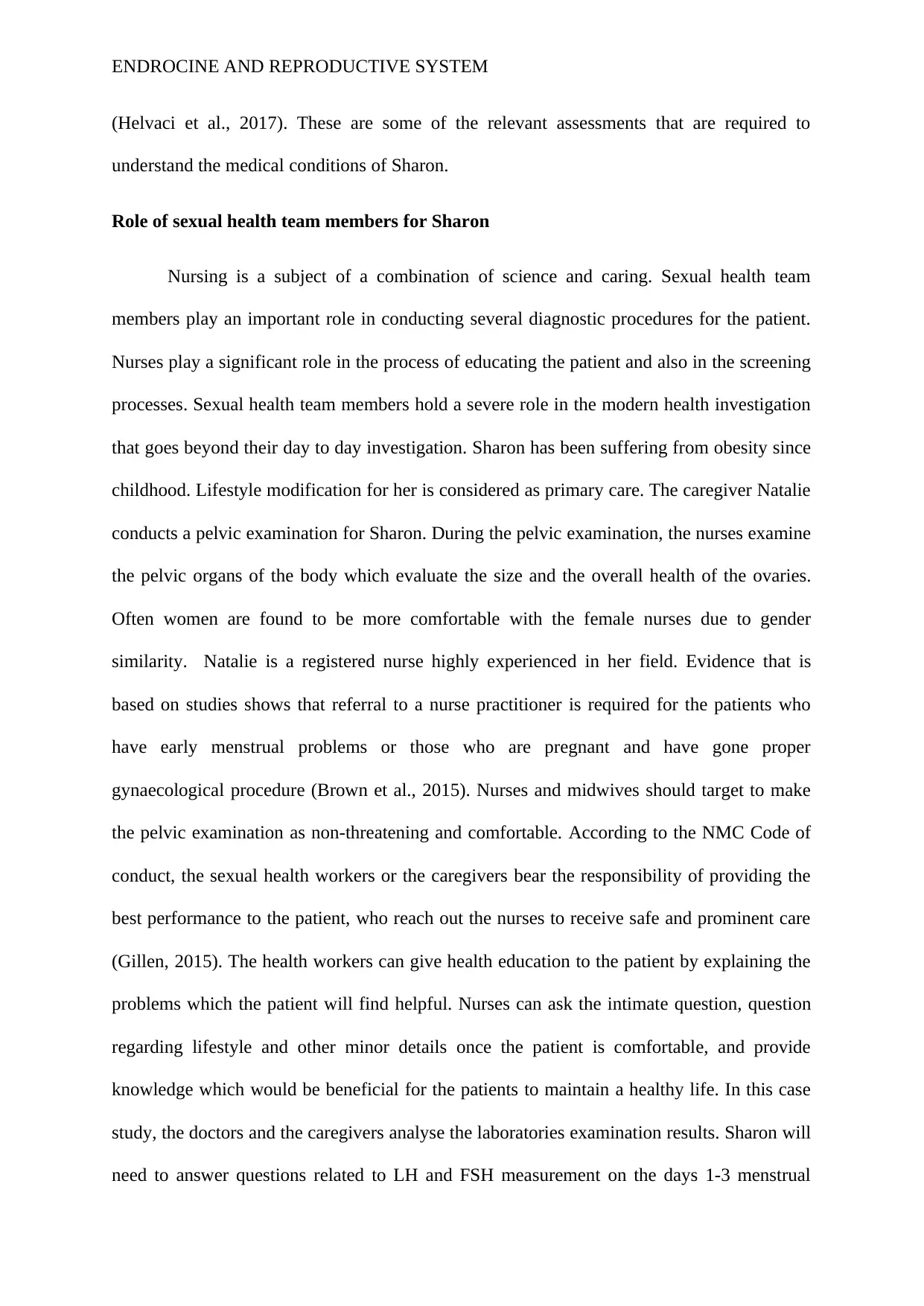
ENDROCINE AND REPRODUCTIVE SYSTEM
(Helvaci et al., 2017). These are some of the relevant assessments that are required to
understand the medical conditions of Sharon.
Role of sexual health team members for Sharon
Nursing is a subject of a combination of science and caring. Sexual health team
members play an important role in conducting several diagnostic procedures for the patient.
Nurses play a significant role in the process of educating the patient and also in the screening
processes. Sexual health team members hold a severe role in the modern health investigation
that goes beyond their day to day investigation. Sharon has been suffering from obesity since
childhood. Lifestyle modification for her is considered as primary care. The caregiver Natalie
conducts a pelvic examination for Sharon. During the pelvic examination, the nurses examine
the pelvic organs of the body which evaluate the size and the overall health of the ovaries.
Often women are found to be more comfortable with the female nurses due to gender
similarity. Natalie is a registered nurse highly experienced in her field. Evidence that is
based on studies shows that referral to a nurse practitioner is required for the patients who
have early menstrual problems or those who are pregnant and have gone proper
gynaecological procedure (Brown et al., 2015). Nurses and midwives should target to make
the pelvic examination as non-threatening and comfortable. According to the NMC Code of
conduct, the sexual health workers or the caregivers bear the responsibility of providing the
best performance to the patient, who reach out the nurses to receive safe and prominent care
(Gillen, 2015). The health workers can give health education to the patient by explaining the
problems which the patient will find helpful. Nurses can ask the intimate question, question
regarding lifestyle and other minor details once the patient is comfortable, and provide
knowledge which would be beneficial for the patients to maintain a healthy life. In this case
study, the doctors and the caregivers analyse the laboratories examination results. Sharon will
need to answer questions related to LH and FSH measurement on the days 1-3 menstrual
(Helvaci et al., 2017). These are some of the relevant assessments that are required to
understand the medical conditions of Sharon.
Role of sexual health team members for Sharon
Nursing is a subject of a combination of science and caring. Sexual health team
members play an important role in conducting several diagnostic procedures for the patient.
Nurses play a significant role in the process of educating the patient and also in the screening
processes. Sexual health team members hold a severe role in the modern health investigation
that goes beyond their day to day investigation. Sharon has been suffering from obesity since
childhood. Lifestyle modification for her is considered as primary care. The caregiver Natalie
conducts a pelvic examination for Sharon. During the pelvic examination, the nurses examine
the pelvic organs of the body which evaluate the size and the overall health of the ovaries.
Often women are found to be more comfortable with the female nurses due to gender
similarity. Natalie is a registered nurse highly experienced in her field. Evidence that is
based on studies shows that referral to a nurse practitioner is required for the patients who
have early menstrual problems or those who are pregnant and have gone proper
gynaecological procedure (Brown et al., 2015). Nurses and midwives should target to make
the pelvic examination as non-threatening and comfortable. According to the NMC Code of
conduct, the sexual health workers or the caregivers bear the responsibility of providing the
best performance to the patient, who reach out the nurses to receive safe and prominent care
(Gillen, 2015). The health workers can give health education to the patient by explaining the
problems which the patient will find helpful. Nurses can ask the intimate question, question
regarding lifestyle and other minor details once the patient is comfortable, and provide
knowledge which would be beneficial for the patients to maintain a healthy life. In this case
study, the doctors and the caregivers analyse the laboratories examination results. Sharon will
need to answer questions related to LH and FSH measurement on the days 1-3 menstrual
Paraphrase This Document
Need a fresh take? Get an instant paraphrase of this document with our AI Paraphraser
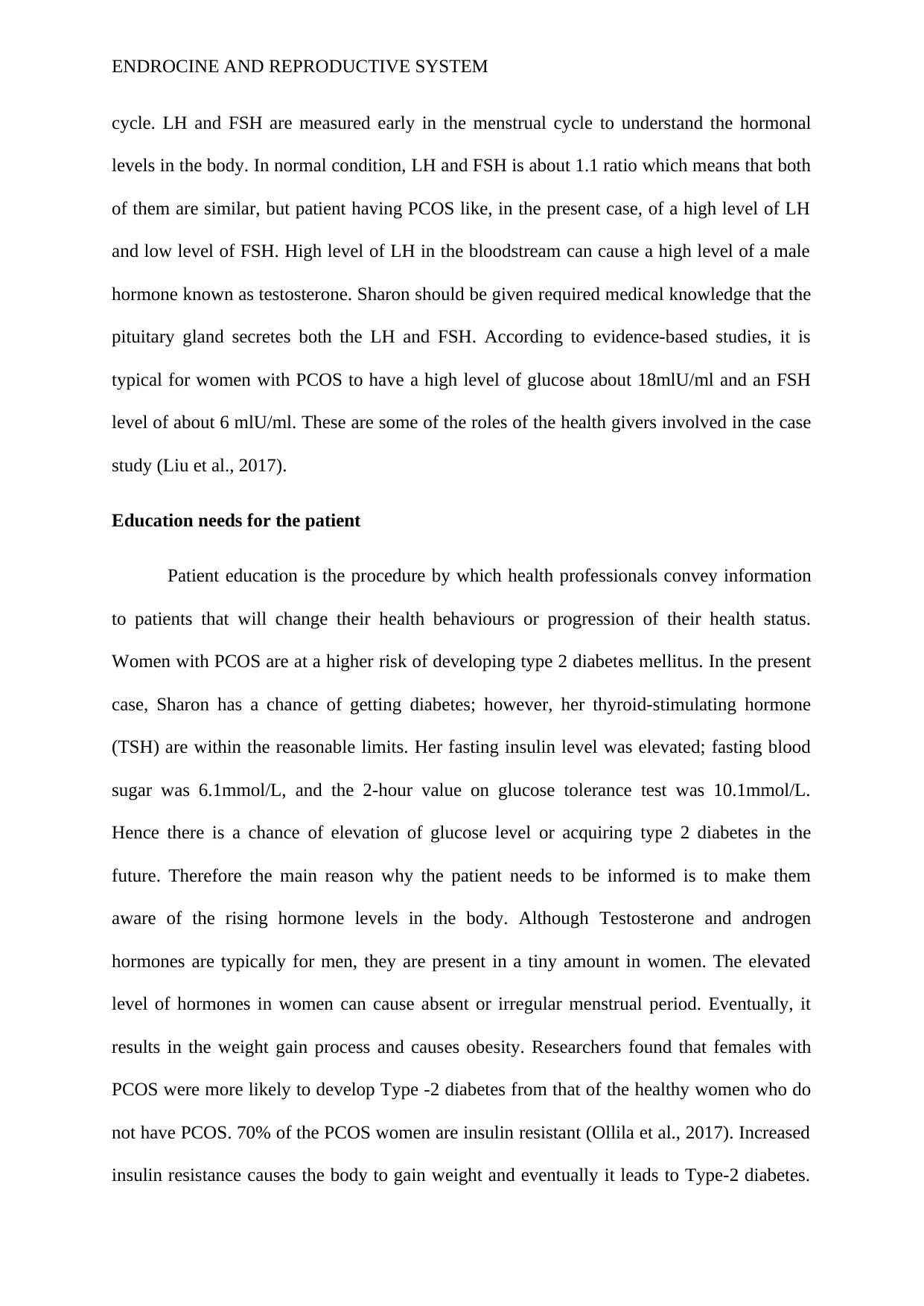
ENDROCINE AND REPRODUCTIVE SYSTEM
cycle. LH and FSH are measured early in the menstrual cycle to understand the hormonal
levels in the body. In normal condition, LH and FSH is about 1.1 ratio which means that both
of them are similar, but patient having PCOS like, in the present case, of a high level of LH
and low level of FSH. High level of LH in the bloodstream can cause a high level of a male
hormone known as testosterone. Sharon should be given required medical knowledge that the
pituitary gland secretes both the LH and FSH. According to evidence-based studies, it is
typical for women with PCOS to have a high level of glucose about 18mlU/ml and an FSH
level of about 6 mlU/ml. These are some of the roles of the health givers involved in the case
study (Liu et al., 2017).
Education needs for the patient
Patient education is the procedure by which health professionals convey information
to patients that will change their health behaviours or progression of their health status.
Women with PCOS are at a higher risk of developing type 2 diabetes mellitus. In the present
case, Sharon has a chance of getting diabetes; however, her thyroid-stimulating hormone
(TSH) are within the reasonable limits. Her fasting insulin level was elevated; fasting blood
sugar was 6.1mmol/L, and the 2-hour value on glucose tolerance test was 10.1mmol/L.
Hence there is a chance of elevation of glucose level or acquiring type 2 diabetes in the
future. Therefore the main reason why the patient needs to be informed is to make them
aware of the rising hormone levels in the body. Although Testosterone and androgen
hormones are typically for men, they are present in a tiny amount in women. The elevated
level of hormones in women can cause absent or irregular menstrual period. Eventually, it
results in the weight gain process and causes obesity. Researchers found that females with
PCOS were more likely to develop Type -2 diabetes from that of the healthy women who do
not have PCOS. 70% of the PCOS women are insulin resistant (Ollila et al., 2017). Increased
insulin resistance causes the body to gain weight and eventually it leads to Type-2 diabetes.
cycle. LH and FSH are measured early in the menstrual cycle to understand the hormonal
levels in the body. In normal condition, LH and FSH is about 1.1 ratio which means that both
of them are similar, but patient having PCOS like, in the present case, of a high level of LH
and low level of FSH. High level of LH in the bloodstream can cause a high level of a male
hormone known as testosterone. Sharon should be given required medical knowledge that the
pituitary gland secretes both the LH and FSH. According to evidence-based studies, it is
typical for women with PCOS to have a high level of glucose about 18mlU/ml and an FSH
level of about 6 mlU/ml. These are some of the roles of the health givers involved in the case
study (Liu et al., 2017).
Education needs for the patient
Patient education is the procedure by which health professionals convey information
to patients that will change their health behaviours or progression of their health status.
Women with PCOS are at a higher risk of developing type 2 diabetes mellitus. In the present
case, Sharon has a chance of getting diabetes; however, her thyroid-stimulating hormone
(TSH) are within the reasonable limits. Her fasting insulin level was elevated; fasting blood
sugar was 6.1mmol/L, and the 2-hour value on glucose tolerance test was 10.1mmol/L.
Hence there is a chance of elevation of glucose level or acquiring type 2 diabetes in the
future. Therefore the main reason why the patient needs to be informed is to make them
aware of the rising hormone levels in the body. Although Testosterone and androgen
hormones are typically for men, they are present in a tiny amount in women. The elevated
level of hormones in women can cause absent or irregular menstrual period. Eventually, it
results in the weight gain process and causes obesity. Researchers found that females with
PCOS were more likely to develop Type -2 diabetes from that of the healthy women who do
not have PCOS. 70% of the PCOS women are insulin resistant (Ollila et al., 2017). Increased
insulin resistance causes the body to gain weight and eventually it leads to Type-2 diabetes.
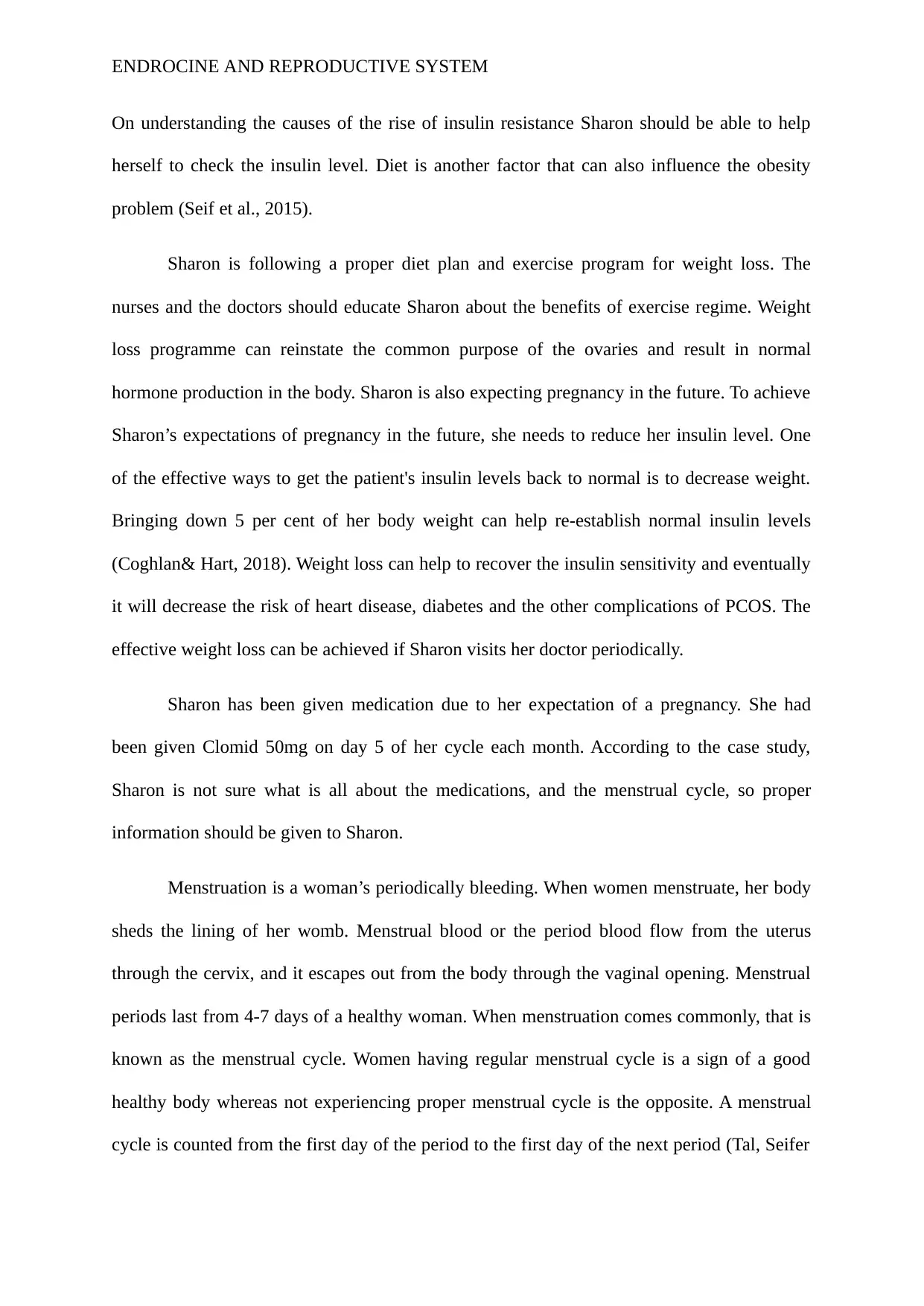
ENDROCINE AND REPRODUCTIVE SYSTEM
On understanding the causes of the rise of insulin resistance Sharon should be able to help
herself to check the insulin level. Diet is another factor that can also influence the obesity
problem (Seif et al., 2015).
Sharon is following a proper diet plan and exercise program for weight loss. The
nurses and the doctors should educate Sharon about the benefits of exercise regime. Weight
loss programme can reinstate the common purpose of the ovaries and result in normal
hormone production in the body. Sharon is also expecting pregnancy in the future. To achieve
Sharon’s expectations of pregnancy in the future, she needs to reduce her insulin level. One
of the effective ways to get the patient's insulin levels back to normal is to decrease weight.
Bringing down 5 per cent of her body weight can help re-establish normal insulin levels
(Coghlan& Hart, 2018). Weight loss can help to recover the insulin sensitivity and eventually
it will decrease the risk of heart disease, diabetes and the other complications of PCOS. The
effective weight loss can be achieved if Sharon visits her doctor periodically.
Sharon has been given medication due to her expectation of a pregnancy. She had
been given Clomid 50mg on day 5 of her cycle each month. According to the case study,
Sharon is not sure what is all about the medications, and the menstrual cycle, so proper
information should be given to Sharon.
Menstruation is a woman’s periodically bleeding. When women menstruate, her body
sheds the lining of her womb. Menstrual blood or the period blood flow from the uterus
through the cervix, and it escapes out from the body through the vaginal opening. Menstrual
periods last from 4-7 days of a healthy woman. When menstruation comes commonly, that is
known as the menstrual cycle. Women having regular menstrual cycle is a sign of a good
healthy body whereas not experiencing proper menstrual cycle is the opposite. A menstrual
cycle is counted from the first day of the period to the first day of the next period (Tal, Seifer
On understanding the causes of the rise of insulin resistance Sharon should be able to help
herself to check the insulin level. Diet is another factor that can also influence the obesity
problem (Seif et al., 2015).
Sharon is following a proper diet plan and exercise program for weight loss. The
nurses and the doctors should educate Sharon about the benefits of exercise regime. Weight
loss programme can reinstate the common purpose of the ovaries and result in normal
hormone production in the body. Sharon is also expecting pregnancy in the future. To achieve
Sharon’s expectations of pregnancy in the future, she needs to reduce her insulin level. One
of the effective ways to get the patient's insulin levels back to normal is to decrease weight.
Bringing down 5 per cent of her body weight can help re-establish normal insulin levels
(Coghlan& Hart, 2018). Weight loss can help to recover the insulin sensitivity and eventually
it will decrease the risk of heart disease, diabetes and the other complications of PCOS. The
effective weight loss can be achieved if Sharon visits her doctor periodically.
Sharon has been given medication due to her expectation of a pregnancy. She had
been given Clomid 50mg on day 5 of her cycle each month. According to the case study,
Sharon is not sure what is all about the medications, and the menstrual cycle, so proper
information should be given to Sharon.
Menstruation is a woman’s periodically bleeding. When women menstruate, her body
sheds the lining of her womb. Menstrual blood or the period blood flow from the uterus
through the cervix, and it escapes out from the body through the vaginal opening. Menstrual
periods last from 4-7 days of a healthy woman. When menstruation comes commonly, that is
known as the menstrual cycle. Women having regular menstrual cycle is a sign of a good
healthy body whereas not experiencing proper menstrual cycle is the opposite. A menstrual
cycle is counted from the first day of the period to the first day of the next period (Tal, Seifer
⊘ This is a preview!⊘
Do you want full access?
Subscribe today to unlock all pages.

Trusted by 1+ million students worldwide
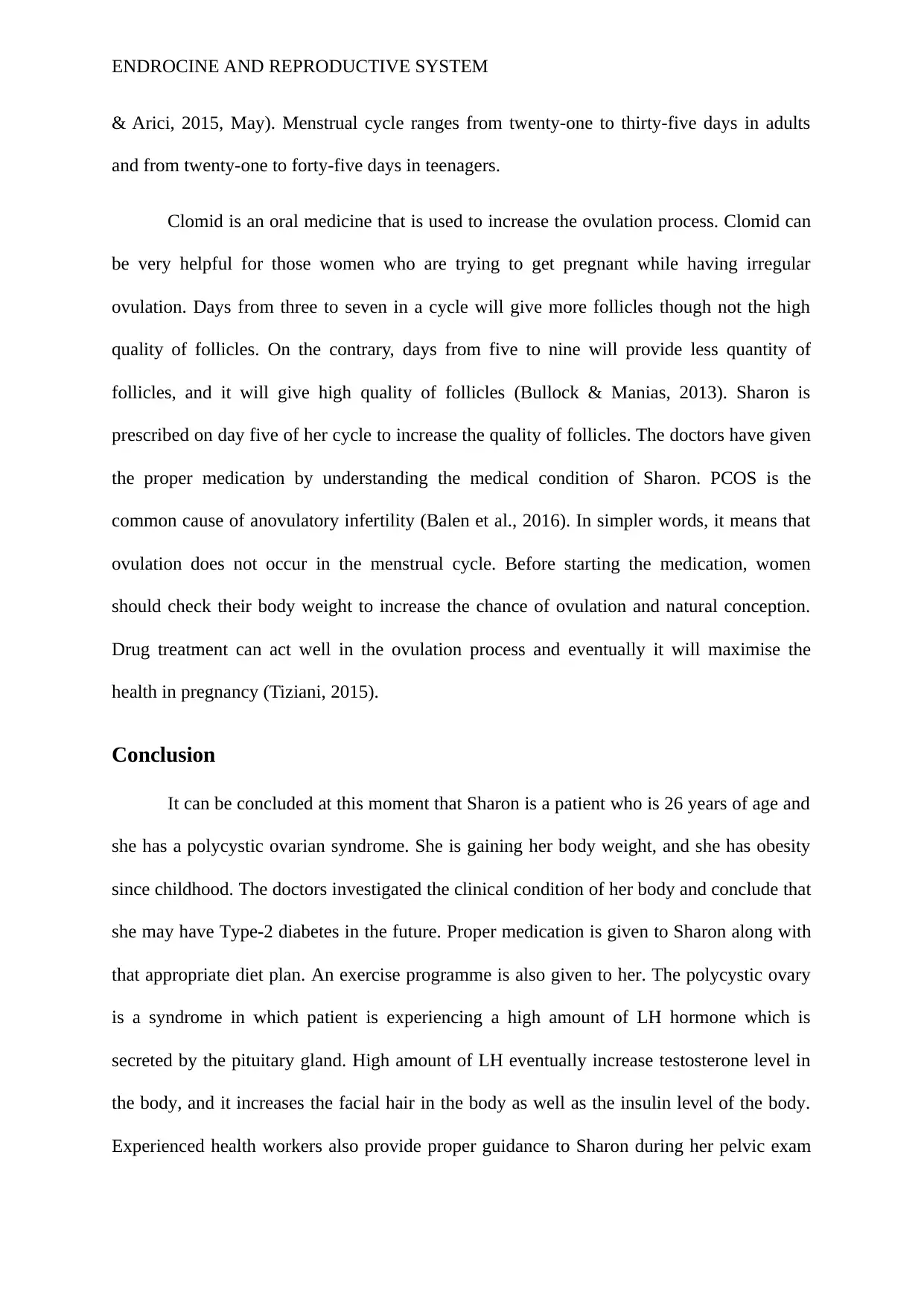
ENDROCINE AND REPRODUCTIVE SYSTEM
& Arici, 2015, May). Menstrual cycle ranges from twenty-one to thirty-five days in adults
and from twenty-one to forty-five days in teenagers.
Clomid is an oral medicine that is used to increase the ovulation process. Clomid can
be very helpful for those women who are trying to get pregnant while having irregular
ovulation. Days from three to seven in a cycle will give more follicles though not the high
quality of follicles. On the contrary, days from five to nine will provide less quantity of
follicles, and it will give high quality of follicles (Bullock & Manias, 2013). Sharon is
prescribed on day five of her cycle to increase the quality of follicles. The doctors have given
the proper medication by understanding the medical condition of Sharon. PCOS is the
common cause of anovulatory infertility (Balen et al., 2016). In simpler words, it means that
ovulation does not occur in the menstrual cycle. Before starting the medication, women
should check their body weight to increase the chance of ovulation and natural conception.
Drug treatment can act well in the ovulation process and eventually it will maximise the
health in pregnancy (Tiziani, 2015).
Conclusion
It can be concluded at this moment that Sharon is a patient who is 26 years of age and
she has a polycystic ovarian syndrome. She is gaining her body weight, and she has obesity
since childhood. The doctors investigated the clinical condition of her body and conclude that
she may have Type-2 diabetes in the future. Proper medication is given to Sharon along with
that appropriate diet plan. An exercise programme is also given to her. The polycystic ovary
is a syndrome in which patient is experiencing a high amount of LH hormone which is
secreted by the pituitary gland. High amount of LH eventually increase testosterone level in
the body, and it increases the facial hair in the body as well as the insulin level of the body.
Experienced health workers also provide proper guidance to Sharon during her pelvic exam
& Arici, 2015, May). Menstrual cycle ranges from twenty-one to thirty-five days in adults
and from twenty-one to forty-five days in teenagers.
Clomid is an oral medicine that is used to increase the ovulation process. Clomid can
be very helpful for those women who are trying to get pregnant while having irregular
ovulation. Days from three to seven in a cycle will give more follicles though not the high
quality of follicles. On the contrary, days from five to nine will provide less quantity of
follicles, and it will give high quality of follicles (Bullock & Manias, 2013). Sharon is
prescribed on day five of her cycle to increase the quality of follicles. The doctors have given
the proper medication by understanding the medical condition of Sharon. PCOS is the
common cause of anovulatory infertility (Balen et al., 2016). In simpler words, it means that
ovulation does not occur in the menstrual cycle. Before starting the medication, women
should check their body weight to increase the chance of ovulation and natural conception.
Drug treatment can act well in the ovulation process and eventually it will maximise the
health in pregnancy (Tiziani, 2015).
Conclusion
It can be concluded at this moment that Sharon is a patient who is 26 years of age and
she has a polycystic ovarian syndrome. She is gaining her body weight, and she has obesity
since childhood. The doctors investigated the clinical condition of her body and conclude that
she may have Type-2 diabetes in the future. Proper medication is given to Sharon along with
that appropriate diet plan. An exercise programme is also given to her. The polycystic ovary
is a syndrome in which patient is experiencing a high amount of LH hormone which is
secreted by the pituitary gland. High amount of LH eventually increase testosterone level in
the body, and it increases the facial hair in the body as well as the insulin level of the body.
Experienced health workers also provide proper guidance to Sharon during her pelvic exam
Paraphrase This Document
Need a fresh take? Get an instant paraphrase of this document with our AI Paraphraser
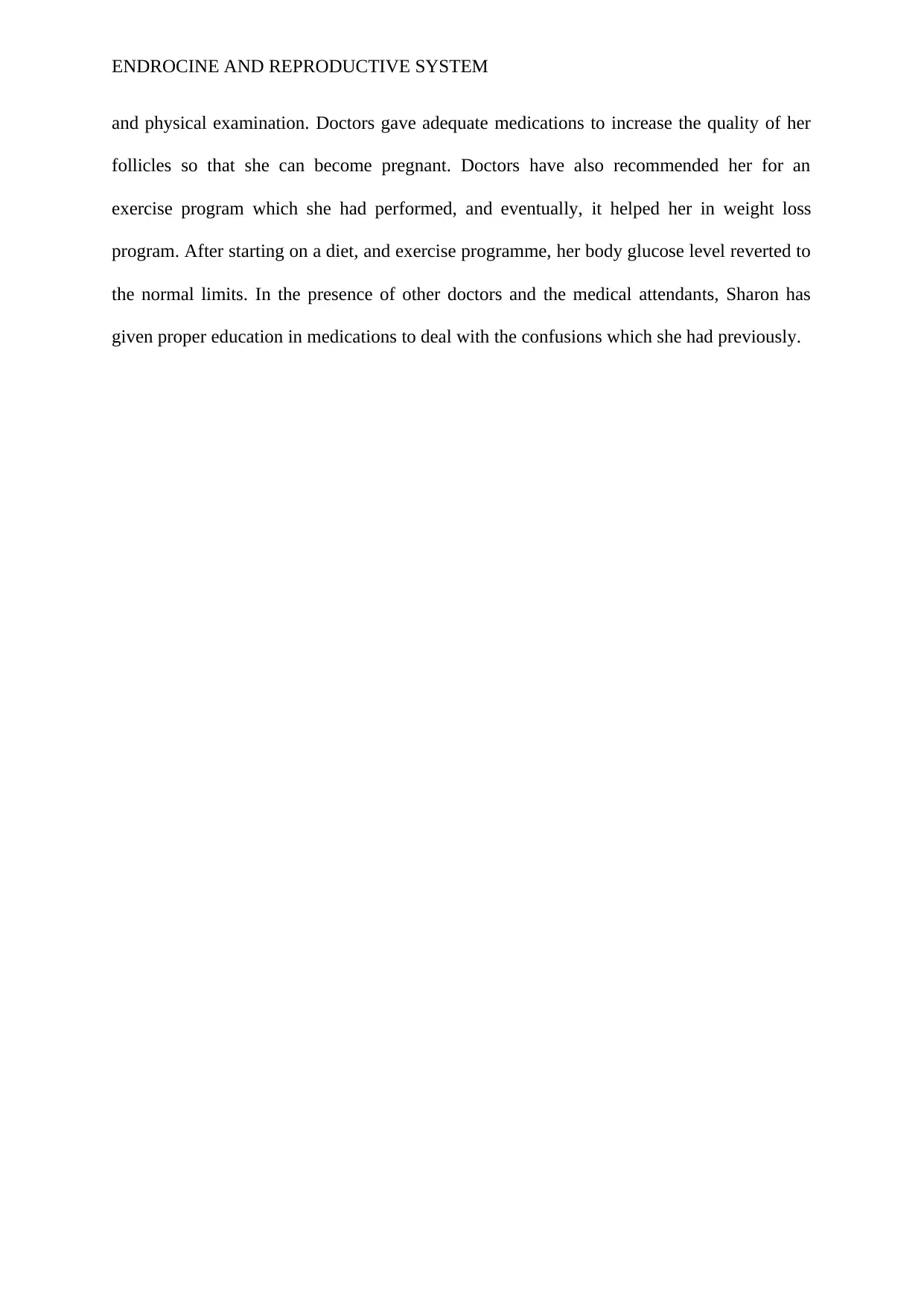
ENDROCINE AND REPRODUCTIVE SYSTEM
and physical examination. Doctors gave adequate medications to increase the quality of her
follicles so that she can become pregnant. Doctors have also recommended her for an
exercise program which she had performed, and eventually, it helped her in weight loss
program. After starting on a diet, and exercise programme, her body glucose level reverted to
the normal limits. In the presence of other doctors and the medical attendants, Sharon has
given proper education in medications to deal with the confusions which she had previously.
and physical examination. Doctors gave adequate medications to increase the quality of her
follicles so that she can become pregnant. Doctors have also recommended her for an
exercise program which she had performed, and eventually, it helped her in weight loss
program. After starting on a diet, and exercise programme, her body glucose level reverted to
the normal limits. In the presence of other doctors and the medical attendants, Sharon has
given proper education in medications to deal with the confusions which she had previously.
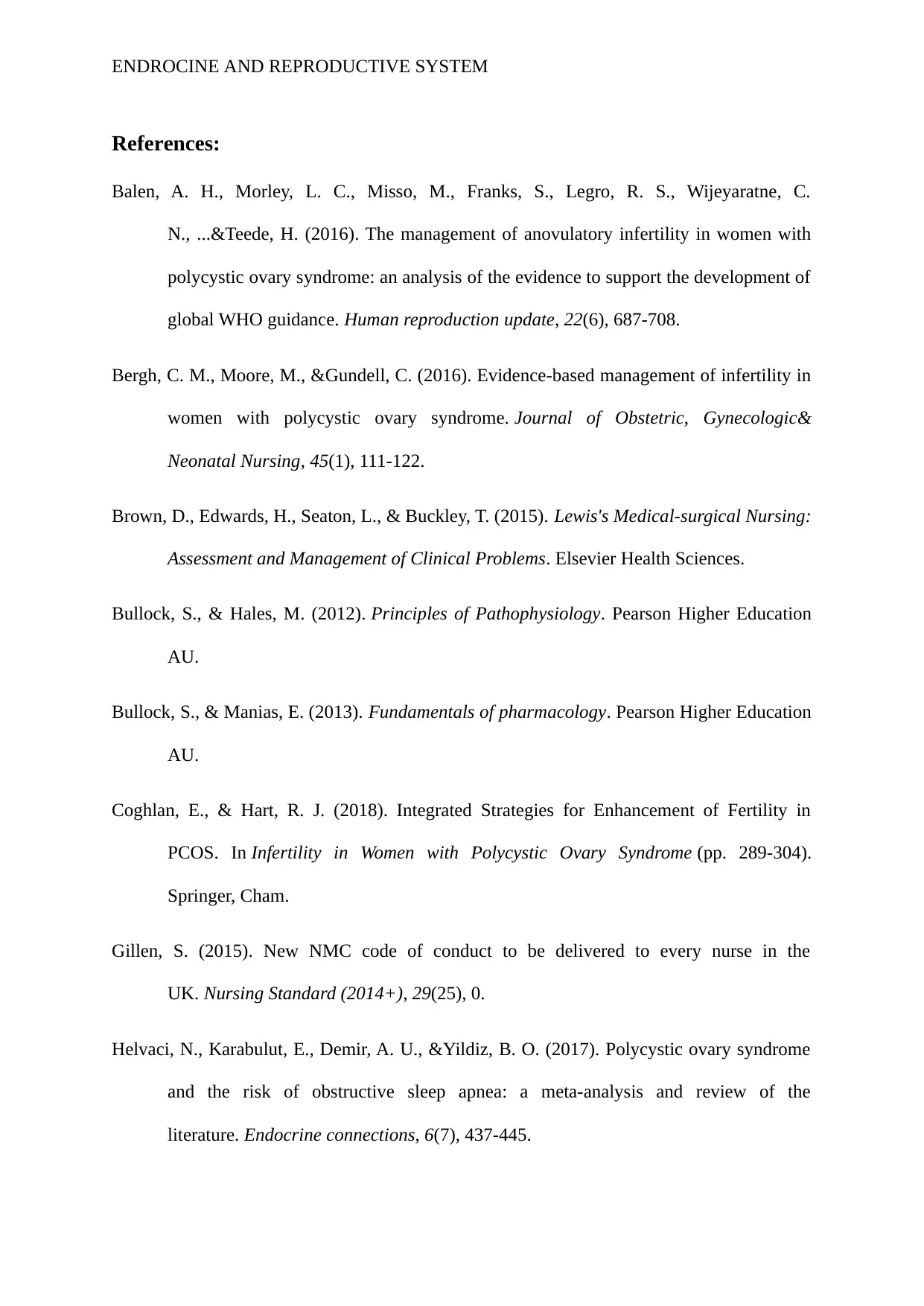
ENDROCINE AND REPRODUCTIVE SYSTEM
References:
Balen, A. H., Morley, L. C., Misso, M., Franks, S., Legro, R. S., Wijeyaratne, C.
N., ...&Teede, H. (2016). The management of anovulatory infertility in women with
polycystic ovary syndrome: an analysis of the evidence to support the development of
global WHO guidance. Human reproduction update, 22(6), 687-708.
Bergh, C. M., Moore, M., &Gundell, C. (2016). Evidence-based management of infertility in
women with polycystic ovary syndrome. Journal of Obstetric, Gynecologic&
Neonatal Nursing, 45(1), 111-122.
Brown, D., Edwards, H., Seaton, L., & Buckley, T. (2015). Lewis's Medical-surgical Nursing:
Assessment and Management of Clinical Problems. Elsevier Health Sciences.
Bullock, S., & Hales, M. (2012). Principles of Pathophysiology. Pearson Higher Education
AU.
Bullock, S., & Manias, E. (2013). Fundamentals of pharmacology. Pearson Higher Education
AU.
Coghlan, E., & Hart, R. J. (2018). Integrated Strategies for Enhancement of Fertility in
PCOS. In Infertility in Women with Polycystic Ovary Syndrome (pp. 289-304).
Springer, Cham.
Gillen, S. (2015). New NMC code of conduct to be delivered to every nurse in the
UK. Nursing Standard (2014+), 29(25), 0.
Helvaci, N., Karabulut, E., Demir, A. U., &Yildiz, B. O. (2017). Polycystic ovary syndrome
and the risk of obstructive sleep apnea: a meta-analysis and review of the
literature. Endocrine connections, 6(7), 437-445.
References:
Balen, A. H., Morley, L. C., Misso, M., Franks, S., Legro, R. S., Wijeyaratne, C.
N., ...&Teede, H. (2016). The management of anovulatory infertility in women with
polycystic ovary syndrome: an analysis of the evidence to support the development of
global WHO guidance. Human reproduction update, 22(6), 687-708.
Bergh, C. M., Moore, M., &Gundell, C. (2016). Evidence-based management of infertility in
women with polycystic ovary syndrome. Journal of Obstetric, Gynecologic&
Neonatal Nursing, 45(1), 111-122.
Brown, D., Edwards, H., Seaton, L., & Buckley, T. (2015). Lewis's Medical-surgical Nursing:
Assessment and Management of Clinical Problems. Elsevier Health Sciences.
Bullock, S., & Hales, M. (2012). Principles of Pathophysiology. Pearson Higher Education
AU.
Bullock, S., & Manias, E. (2013). Fundamentals of pharmacology. Pearson Higher Education
AU.
Coghlan, E., & Hart, R. J. (2018). Integrated Strategies for Enhancement of Fertility in
PCOS. In Infertility in Women with Polycystic Ovary Syndrome (pp. 289-304).
Springer, Cham.
Gillen, S. (2015). New NMC code of conduct to be delivered to every nurse in the
UK. Nursing Standard (2014+), 29(25), 0.
Helvaci, N., Karabulut, E., Demir, A. U., &Yildiz, B. O. (2017). Polycystic ovary syndrome
and the risk of obstructive sleep apnea: a meta-analysis and review of the
literature. Endocrine connections, 6(7), 437-445.
⊘ This is a preview!⊘
Do you want full access?
Subscribe today to unlock all pages.

Trusted by 1+ million students worldwide
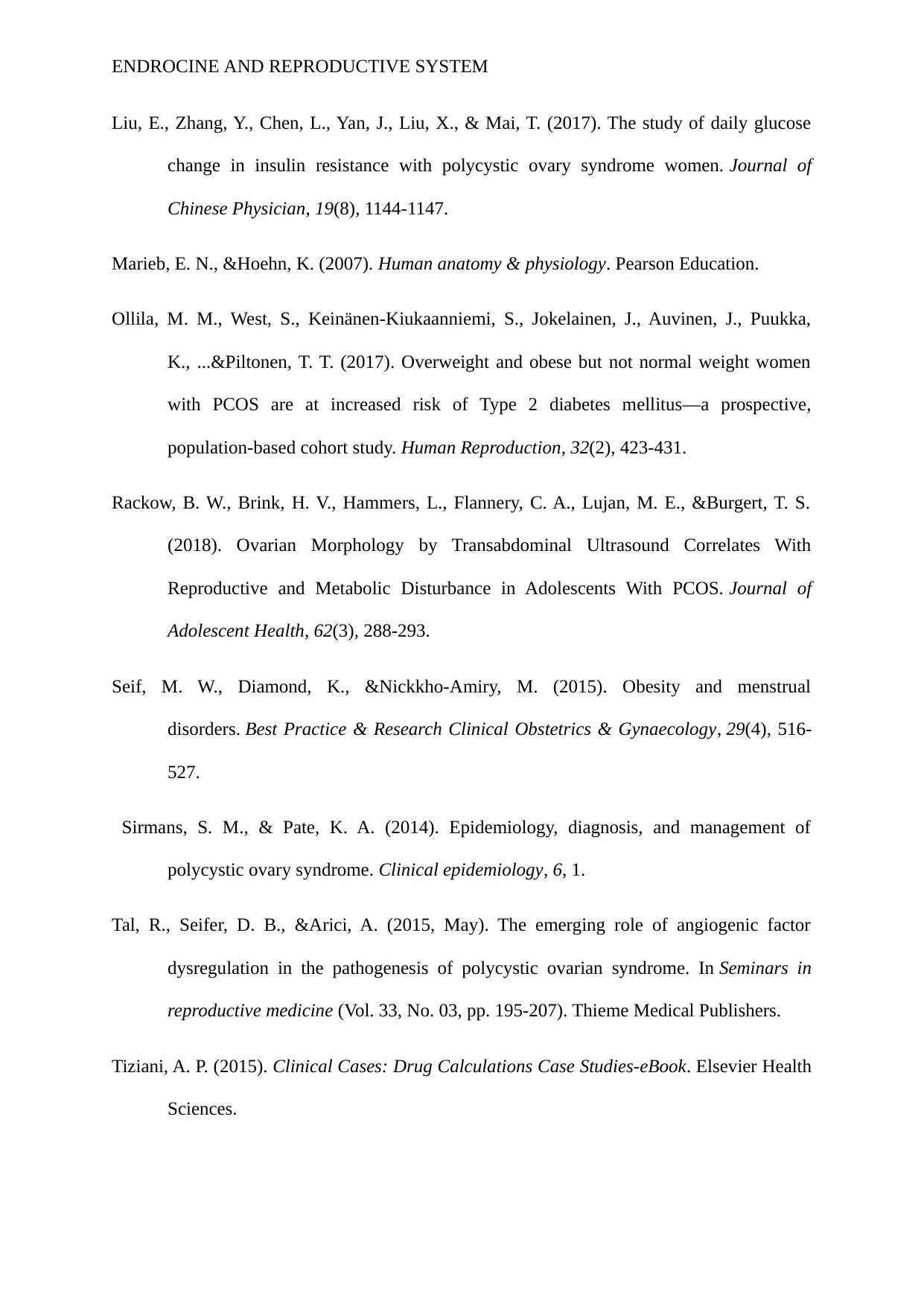
ENDROCINE AND REPRODUCTIVE SYSTEM
Liu, E., Zhang, Y., Chen, L., Yan, J., Liu, X., & Mai, T. (2017). The study of daily glucose
change in insulin resistance with polycystic ovary syndrome women. Journal of
Chinese Physician, 19(8), 1144-1147.
Marieb, E. N., &Hoehn, K. (2007). Human anatomy & physiology. Pearson Education.
Ollila, M. M., West, S., Keinänen-Kiukaanniemi, S., Jokelainen, J., Auvinen, J., Puukka,
K., ...&Piltonen, T. T. (2017). Overweight and obese but not normal weight women
with PCOS are at increased risk of Type 2 diabetes mellitus—a prospective,
population-based cohort study. Human Reproduction, 32(2), 423-431.
Rackow, B. W., Brink, H. V., Hammers, L., Flannery, C. A., Lujan, M. E., &Burgert, T. S.
(2018). Ovarian Morphology by Transabdominal Ultrasound Correlates With
Reproductive and Metabolic Disturbance in Adolescents With PCOS. Journal of
Adolescent Health, 62(3), 288-293.
Seif, M. W., Diamond, K., &Nickkho-Amiry, M. (2015). Obesity and menstrual
disorders. Best Practice & Research Clinical Obstetrics & Gynaecology, 29(4), 516-
527.
Sirmans, S. M., & Pate, K. A. (2014). Epidemiology, diagnosis, and management of
polycystic ovary syndrome. Clinical epidemiology, 6, 1.
Tal, R., Seifer, D. B., &Arici, A. (2015, May). The emerging role of angiogenic factor
dysregulation in the pathogenesis of polycystic ovarian syndrome. In Seminars in
reproductive medicine (Vol. 33, No. 03, pp. 195-207). Thieme Medical Publishers.
Tiziani, A. P. (2015). Clinical Cases: Drug Calculations Case Studies-eBook. Elsevier Health
Sciences.
Liu, E., Zhang, Y., Chen, L., Yan, J., Liu, X., & Mai, T. (2017). The study of daily glucose
change in insulin resistance with polycystic ovary syndrome women. Journal of
Chinese Physician, 19(8), 1144-1147.
Marieb, E. N., &Hoehn, K. (2007). Human anatomy & physiology. Pearson Education.
Ollila, M. M., West, S., Keinänen-Kiukaanniemi, S., Jokelainen, J., Auvinen, J., Puukka,
K., ...&Piltonen, T. T. (2017). Overweight and obese but not normal weight women
with PCOS are at increased risk of Type 2 diabetes mellitus—a prospective,
population-based cohort study. Human Reproduction, 32(2), 423-431.
Rackow, B. W., Brink, H. V., Hammers, L., Flannery, C. A., Lujan, M. E., &Burgert, T. S.
(2018). Ovarian Morphology by Transabdominal Ultrasound Correlates With
Reproductive and Metabolic Disturbance in Adolescents With PCOS. Journal of
Adolescent Health, 62(3), 288-293.
Seif, M. W., Diamond, K., &Nickkho-Amiry, M. (2015). Obesity and menstrual
disorders. Best Practice & Research Clinical Obstetrics & Gynaecology, 29(4), 516-
527.
Sirmans, S. M., & Pate, K. A. (2014). Epidemiology, diagnosis, and management of
polycystic ovary syndrome. Clinical epidemiology, 6, 1.
Tal, R., Seifer, D. B., &Arici, A. (2015, May). The emerging role of angiogenic factor
dysregulation in the pathogenesis of polycystic ovarian syndrome. In Seminars in
reproductive medicine (Vol. 33, No. 03, pp. 195-207). Thieme Medical Publishers.
Tiziani, A. P. (2015). Clinical Cases: Drug Calculations Case Studies-eBook. Elsevier Health
Sciences.
Paraphrase This Document
Need a fresh take? Get an instant paraphrase of this document with our AI Paraphraser

ENDROCINE AND REPRODUCTIVE SYSTEM
1 out of 11
Related Documents
Your All-in-One AI-Powered Toolkit for Academic Success.
+13062052269
info@desklib.com
Available 24*7 on WhatsApp / Email
![[object Object]](/_next/static/media/star-bottom.7253800d.svg)
Unlock your academic potential
Copyright © 2020–2025 A2Z Services. All Rights Reserved. Developed and managed by ZUCOL.





